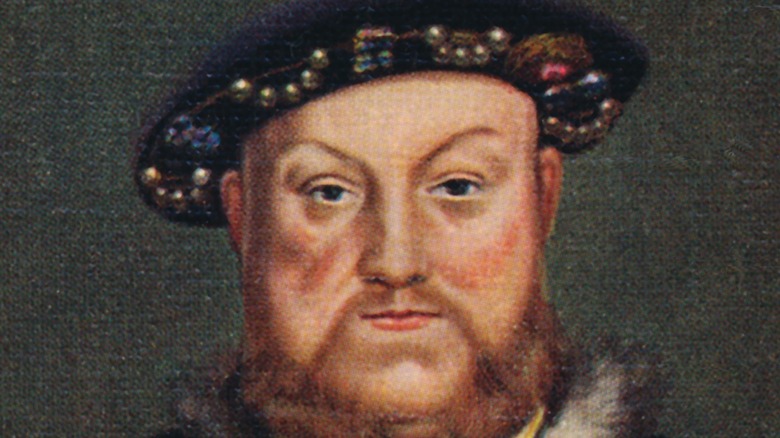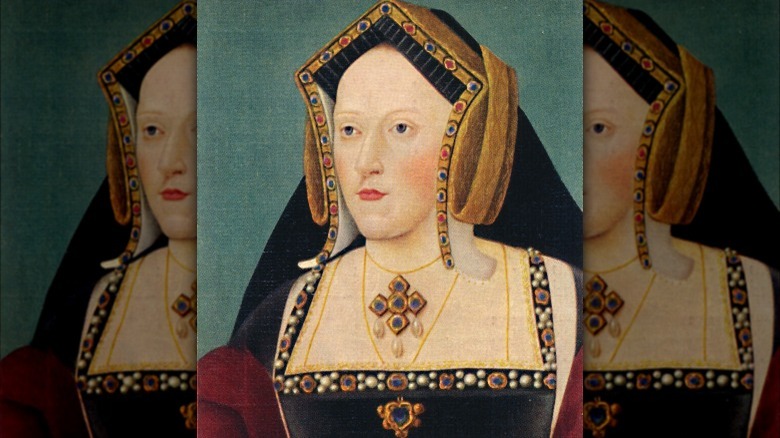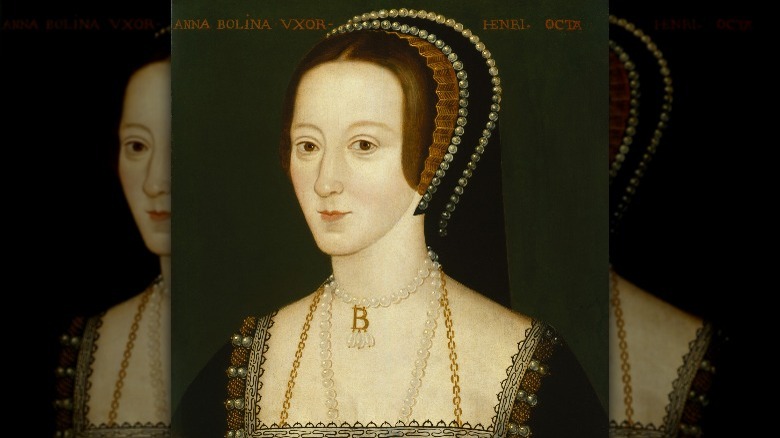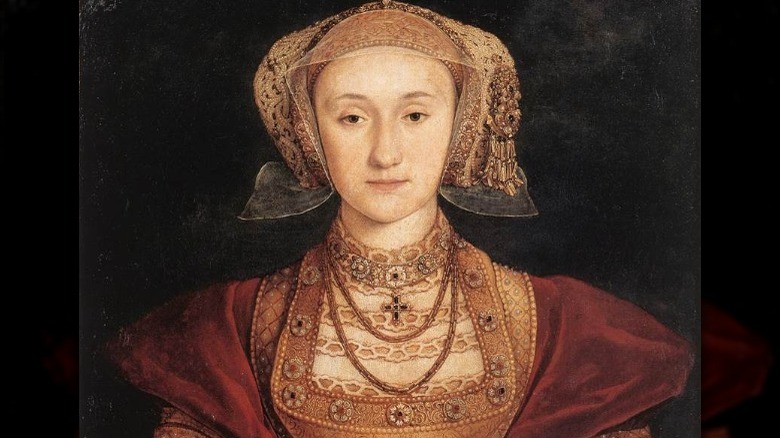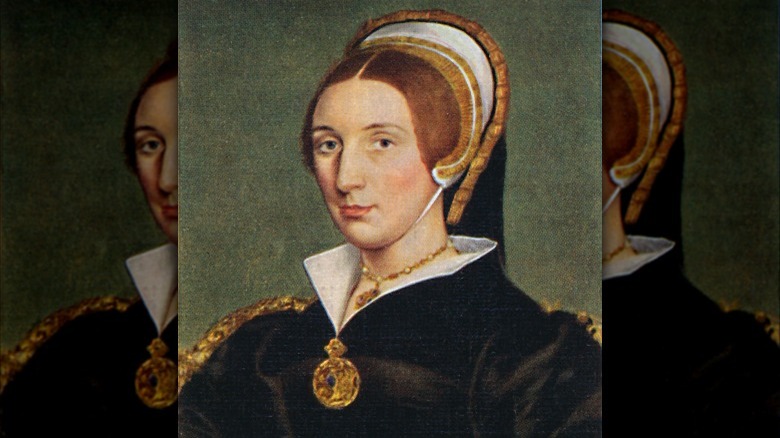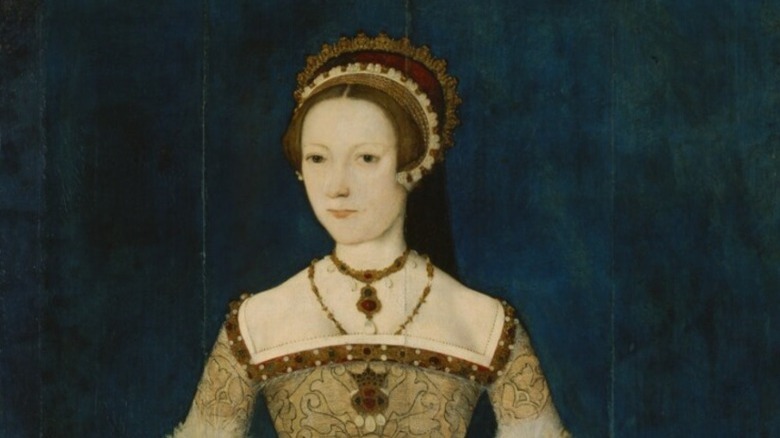How Many Wives Did Henry VIII Have?
King Henry VIII, who ruled England from 1509 to 1547, is one of the most notorious monarchs in history. Henry the VIII was born to Henry VII and Elizabeth of York. He was an intelligent boy who enjoyed hunting, as well as music (via Royal). He composed music and played various string and wind instruments and was well-educated about various subjects, such as theology, sports, languages, and poetry. He had an older brother, Arthur, who was in line to inherit the throne, but he died of an illness. This left Henry VIII the next in line of succession to the throne.
Arthur had been affianced to Catherine of Aragon since he was 2 years old. He married her in 1501 when he was 15 years old, but he died just months after the union, per History. Henry VIII was then betrothed to his brother's widow, and they married soon after his coronation at 17 years old. Catherine of Aragon would be the first of six wives King Henry VIII would have in his lifetime.
Catherine of Aragon
Catherine of Aragon was the daughter of Spain's King Ferdinand and Queen Isabella. She was 23 years old when she married King Henry VIII, and their union lasted for almost 24 years, the longest marriage the king had among all his wives. Catherine of Aragon was betrothed to Arthur because of an alliance with the Spanish, and when he died, Henry VIII's father gave his blessing for his younger son to marry his older son's widow. However, as reported by Historic Royal Palaces, it wasn't just a political move for Henry VIII; he was genuinely interested in Catherine despite being six years younger than her.
King Henry VIII put his full trust in Catherine, and for a time, they were genuinely happy together. As the years passed, however, Catherine was not able to produce a male heir to the King, and that became an issue for the couple. Per World History, the couple had six children, but only one survived infancy: Mary I. By the time Catherine was in her early 40s, it seemed apparent to King Henry VIII that his wife wouldn't be able to give him a son. A young lady named Anne Boleyn had also caught his attention, and he decided to have his marriage annulled in 1533. Henry claimed that the marriage shouldn't have been official in the first place since Catherine was married to his brother, but she argued that the union wasn't consummated. In the end, the King got what he wanted, and he immediately went on to marry his second wife.
Anne Boleyn
Anne Boleyn and King Henry VIII were married from 1533 up to 1536. Henry VIII first took notice of Anne while he was having an affair with her sister, Mary. Anne was also one of Catherine of Aragon's ladies-in-waiting. He began showing his interest in the young lady while he was still married to Catherine, but Anne initially refuted the king's advances. As Royal Museums Greenwich noted, however, that all changed when Henry VIII proposed marriage. They were secretly wed in 1933, just weeks after Henry VIII's annulment.
The union soon resulted in a child — Elizabeth I — who was born in 1533. King Henry VIII still wanted a male heir, but her subsequent pregnancies resulted in miscarriages. Once again, the king was left with no son. There's speculation surrounding the downfall of Anne Boleyn. She was accused of incest, adultery, and conspiracy against King Henry VIII, but according to Smithsonian Magazine, the real reason the king wanted to get rid of her was that she wasn't able to give him a son. Historians say that there were no pieces of evidence to prove the charges, and Anne insisted she was innocent until the end. Anne was held prisoner in the Tower of London until she was beheaded on May 19, 1536.
Jane Seymour
King Henry VIII already had his eyes on Jane Seymour before Anne Boleyn was out of the picture. She was Anne Boleyn's lady-in-waiting, and the king started courting her as early as 1534. At first, Jane ignored King Henry VIII's advances, but by the time Anne was imprisoned, their relationship had blossomed (via Historic Royal Palaces). Their marriage took place a little over a week after Anne's beheading. However, a coronation never took place. There was an ongoing plague at the time, and Jane was at the latter stage of her pregnancy. It was then decided that her coronation be postponed.
In October 1534, Jane gave birth to a son — Edward VI — and finally gave King Henry VIII the male heir that he always wanted. It is for that reason that many believe Jane was the king's favorite wife. The union was brief, however, as Jane died several days after giving birth, as reported by History Hit. It is believed that her cause of death was complications from her pregnancy. Her coronation never happened, but out of all Henry VIII's wives, she was the only one who had a funeral fit for a queen. The king chose to be buried beside Jane Seymour upon his death, and he was laid to rest beside her at St. George's Chapel in Windsor when he died in 1547.
Anne of Cleves
After the death of Jane Seymour, King Henry VIII took time to mourn. In 1540, he married his fourth wife, Anne of Cleves. However, the union only took place as England needed a foreign ally. Anne was from Germany, and a portrait was painted of her so that King Henry VIII could see what his future spouse looked like. However, as Smithsonian Magazine noted, the king was displeased upon seeing her in person. "I like her not," he reportedly stated. Unlike his past wives, Anne of Cleves was voluptuous, big-boned, and not well-versed in English. Still, the marriage took place for the sake of an alliance.
King Henry VIII surmised that Anne was not a maiden after their wedding night. He said she had "evil smells" and "the looseness of her breasts" suggested that she had already given up her virtue, which he said prevented him from consummating their marriage, per History Extra. However, there was no evidence to support the king's claim, and based on records, it seemed that Anne didn't even know what entailed consummation, as she assumed that all it took to get pregnant was a few kisses from the king. King Henry VIII had their marriage annulled just six months after their marriage, making their union the shortest among his six wives. Anne was given compensation and remained in England. She maintained a good relationship with King Henry VIII and his children even after a brief marriage, and she was considered an honorary member of the royal family.
Catherine Howard
Catherine Howard was King Henry VIII's fifth wife. She was Anne of Cleves' lady-in-waiting, and interestingly, Anne Boleyn's cousin. The two wed in July 1540, just a few weeks after the king's previous marriage was annulled. According to Historic Royal Palaces, Catherine was beautiful and lively. The king showered his new bride with lavish presents and called her his "rose without a thorn." At that time, the king was in his late 40s and was at least 30 years older than Catherine.
A year into their marriage, however, rumors spread about Catherine's infidelity, and it reached King Henry VIII. She was also found to have had relations with men before being married to the king. Catherine was charged with treason under the 1534 Treason Act, which stated that anyone could be deemed a traitor. The Royal Assent by Commission Act of 1541 was also passed, which meant that not disclosing former sexual relations at least 20 days before the marriage was considered treason (per History Hit). Catherine Howard and King Henry VIII's marriage lasted only 18 months. She was beheaded at the Tower of London in February 1542.
Catherine Parr
Catherine Parr was twice widowed when she married King Henry VIII in 1543 and came from a well-to-do family. Per an article by History Extra, Catherine was in love with another man — Thomas Seymour, Jane Seymour's brother — when she received a marriage proposal from the king, but she eventually agreed to marry him. She made an effort to make the marriage work and was passionate about her beliefs. She took care of her husband — who suffered from chronic pains by that time — and his children.
The sixth wife of King Henry VIII supported the Protestant church, which caused many in the king's court to dislike her. Anti-Protestants in the king's court plotted to get rid of her and she was arrested for heresy, but she was able to convince the king of her loyalty to him. Catherine was able to provide a stable life for her husband and his children and was influential in various fields, such as religion, court culture, and languages. As Historic UK noted, King Henry VIII trusted her so much that she was named regent while he was away at war with France in 1544. Catherine Parr became a widow on January 28, 1547, when the king died of natural causes at 55 years old. She then married her true love, Seymour, but she died just days after giving birth in 1548.
